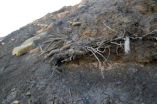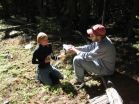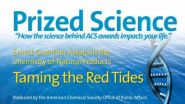(Press-News.org) SAN FRANCISCO -- The northernmost mummified forest ever found in Canada is revealing how plants struggled to endure a long-ago global cooling.
Researchers believe the trees -- buried by a landslide and exquisitely preserved 2 to 8 million years ago -- will help them predict how today's Arctic will respond to global warming.
They also suspect that many more mummified forests could emerge across North America as Arctic ice continues to melt. As the wood is exposed and begins to rot, it could release significant amounts of methane and carbon dioxide into the atmosphere -- and actually boost global warming.
Joel Barker, a research scientist at Byrd Polar Research Center and the School of Earth Sciences at Ohio State University and leader of the team that is analyzing the remains, will describe early results at the American Geophysical Union meeting in San Francisco on Friday, December 17.
Over the summer of 2010, the researchers retrieved samples from broken tree trunks, branches, roots, and even leaves -- all perfectly preserved -- from Ellesmere Island National Park in Canada.
"Mummified forests aren't so uncommon, but what makes this one unique is that it's so far north. When the climate began to cool 11 million years ago, these plants would have been the first to feel the effects," Barker said. "And because the trees' organic material is preserved, we can get a high-resolution view of how quickly the climate changed and how the plants responded to that change."
Barker found the deposit in 2009, when he was camping on Ellesmere Island for an unrelated research project. He followed a tip from a national park warden, who had noticed some wood sticking out of the mud next to a melting glacier. This summer, he returned with colleagues for a detailed study of the area.
Analysis of the remains has only just begun, but will include chemical and DNA testing.
For now, the researchers have identified the species of the most common trees at the site -- spruce and birch. The trees were at least 75 years old when they died, but spindly, with very narrow growth rings and under-sized leaves that suggest they were suffering a great deal of stress when they were alive.
"These trees lived at a particularly rough time in the Arctic," Barker explained. "Ellesmere Island was quickly changing from a warm deciduous forest environment to an evergreen environment, on its way to the barren scrub we see today. The trees would have had to endure half of the year in darkness and in a cooling climate. That's why the growth rings show that they grew so little, and so slowly."
Colleagues at the University of Minnesota identified the wood from the deposit, and pollen analysis at a commercial laboratory in Calgary, Alberta revealed that the trees lived approximately 2 to 8 million years ago, during the Neogene Period. The pollen came from only a handful of plant species, which suggests that Arctic biodiversity had begun to suffer during that time as well.
The team is now working to identify other mummified plants at the site, scanning the remains under microscopes to uncover any possible seeds or insect remains.
Now that the forest is exposed, it's begun to rot, which means that it's releasing carbon into the atmosphere, where it can contribute to global warming.
Team member David Elliot, professor emeritus of earth sciences at Ohio State, said that the mummified forest on Ellesmere Island doesn't pose an immediate threat to the environment, though.
"I want to be clear -- the carbon contained in the small deposit we've been studying is trivial compared to what you produce when you drive your car," he said. "But if you look at this find in the context of the whole Arctic, then that is a different issue. I would expect other isolated deposits to be exposed as the ice melts, and all that biomass is eventually going to return to carbon dioxide if it's exposed to the air."
"It's a big country, and unless people decide to walk all across the Canadian Arctic, we won't know how many deposits are out there," he added.
INFORMATION:
Other collaborators on the project include Yu-Ping Chin, professor of earth sciences at Ohio State, and Joel Jurgens and Robert Blanchette, both plant pathologists at the University of Minnesota.
This research was funded by an EArly-concept Grant for Exploratory Research from the National Science Foundation.
Contact: Joel Barker, (614) 247-6051; Barker.246@osu.edu
Written by Pam Frost Gorder, (614) 292-9475; Gorder.1@osu.edu
Ancient forest emerges mummified from the Arctic
2010-12-16
ELSE PRESS RELEASES FROM THIS DATE:
New colonoscopy skills assessment tool developed for trainees
2010-12-16
OAK BROOK, Ill. – Dec. 15, 2010 – Researchers at the Mayo Clinic in Rochester, Minn., have developed a new skills assessment tool for colonoscopy trainees. A report outlining the development and validation of the Mayo Colonoscopy Skills Assessment Tool (MCSAT), designed for the assessment of cognitive and motor skills during colonoscopy training, appears in the December issue of GIE: Gastrointestinal Endoscopy, the monthly peer-reviewed scientific journal of the American Society for Gastrointestinal Endoscopy (ASGE).
Ensuring that gastroenterology fellows and surgery ...
Missing molecules hold promise of therapy for pancreatic cancer
2010-12-16
By determining what goes missing in human cells when the gene that is most commonly mutated in pancreatic cancer gets turned on, Johns Hopkins scientists have discovered a potential strategy for therapy.
The production of a particular cluster of genetic snippets known as microRNAs is dramatically reduced in human pancreatic tumor cells compared to healthy tissue, the researchers report in a study published Dec. 15 in Genes and Development. When the team restored this tiny regulator, called miR-143/145, back to normal levels in human pancreatic cancer cells, those cells ...
Nanoscale gene 'ignition switch' may help spot and treat cancer
2010-12-16
In a proof of principal study in mice, scientists at Johns Hopkins and the Virginia Commonwealth University (VCU) have shown that a set of genetic instructions encased in a nanoparticle can be used as an "ignition switch" to rev up gene activity that aids cancer detection and treatment.
The switch, called a promoter, is a set of chemical letters that interacts with DNA to turn on gene activity. In this case, the scientists used a promoter called PEG-Prom, cloned by VCU researcher Paul Fisher, Ph.D. PEG-Prom is activated only when inside cancer cells, not in normal ones.
"With ...
UGA researchers develop rapid diagnostic test for common type of pneumonia
2010-12-16
Athens, Ga. – University of Georgia researchers have developed a technique that can diagnose a common type of pneumonia within minutes, potentially replacing existing tests that can take several days for results.
The researchers, whose findings are detailed online in the journal PLoS ONE, detected Mycoplasma pneumoniae, which causes atypical or "walking pneumonia," in true clinical samples with over 97 percent accuracy using a recently-developed nanotechnology-based platform.
"If you can make a positive identification from a 10-minute test, then appropriate antibiotics ...
A positive mood allows your brain to think more creatively
2010-12-16
People who watch funny videos on the internet at work aren't necessarily wasting time. They may be taking advantage of the latest psychological science—putting themselves in a good mood so they can think more creatively.
"Generally, positive mood has been found to enhance creative problem solving and flexible yet careful thinking," says Ruby Nadler, a graduate student at the University of Western Ontario. She and colleagues Rahel Rabi and John Paul Minda carried out a new study published in Psychological Science, a journal of the Association for Psychological Science. ...
Protein disables p53, drives breast cells toward cancer transition
2010-12-16
HOUSTON - The recently identified TRIM24 protein plays an active role in pushing normal breast cells into rapid cell proliferation and, potentially, into breast cancer.
Reporting in the journal Nature, a team led by researchers at The University of Texas MD Anderson Cancer Center found that TRIM24 (tripartite motif-containing 24) pushes estrogen-responsive genes toward active expression. This expression, in turn, sets the stage for malignant transformation of breast cells. TRIM24 functions by reading a specific code, or signature, present at estrogen-regulated genes and ...
Elevated zinc concentrations in Colorado waterway likely a result of climate change
2010-12-16
Rising concentrations of zinc in a waterway on Colorado's Western Slope may be the result of climate change that is affecting the timing of annual snowmelt, says a new study led by the University of Colorado at Boulder.
The study focused on the Snake River watershed just west of the Continental Divide near Keystone, Colo., where CU-Boulder researchers have observed a four-fold increase in dissolved zinc over the last 30 years during the lowest water flow months, said Caitlin Crouch. Crouch, a master's degree student who led the study, said the high levels of zinc affect ...
Study improves understanding of method for creating multi-metal nanoparticles
2010-12-16
A new study from researchers at North Carolina State University sheds light on how a technique that is commonly used for making single-metal nanoparticles can be extended to create nanoparticles consisting of two metals – and that have tunable properties. The study also provides insight into the optical properties of some of these nanoparticles.
Tuning the optical properties of nanoparticles is of interest for applications such as security technology, and for use in making chemical reactions more efficient – which has multiple industrial and environmental applications. ...
New American Chemical Society Prized Science video on 'red tide' shellfish poisoning
2010-12-16
WASHINGTON, Dec. 15, 2010 — The quest to cure a terrible form of food poisoning caused by population explosions of algae that stain the water red and produce a potent toxin is the topic of a new episode in the American Chemical Society (ACS) Prized Science video series.
Entitled "Taming the Red Tides," the high-definition video, released today, focuses on Michael Crimmins, Ph.D., winner of the 2010 Ernest Guenther Award in the Chemistry of Natural Products. Crimmins, a chemist at the University of North Carolina in Chapel Hill, studies brevetoxin A, a poison produced ...
Study supports gluten-free diet in potential celiac disease patients
2010-12-16
Findings from a new study of 141 adults add to an ongoing medical debate over which patients with symptoms of celiac disease should go on a gluten-free diet. Published in ACS' Journal of Proteome Research, the study concludes that people currently diagnosed as "potential" celiac disease patients and not advised to follow a gluten-free diet may not be "potential" patients at all. Rather, the scientists found that these patients have the same distinctive metabolic fingerprint as patients with full-blown disease who do benefit from gluten-free diets.
In the study, Ivano ...



